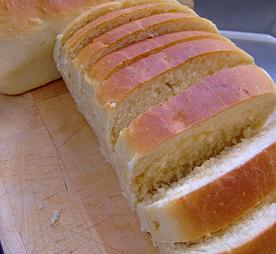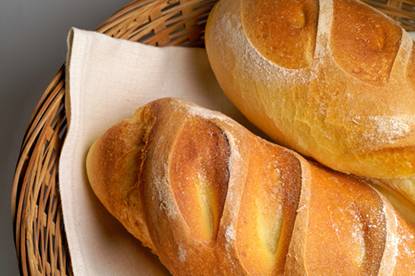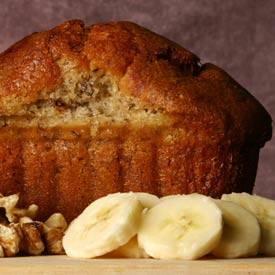|
Tips for Perfect Bread
By Camille Rhoades
 Who doesn’t love bread? I mean, lets me honest here. If I had to choose just one kind of food to eat for the rest of my life it would be breads. My round figure may indicate that I have too great a love for such things, but how can I help it? Toast, sandwiches, banana bread, rolls, garlic bread, muffins, cakes, bagels... What is not to LOVE?
So now that we all agree that breads are a little blessing from Heaven we can move on. So, what is better than bread? Fresh, warm, soft bread that fills the house with that wonderful aroma and makes all your troubles melt away! Okay, okay, my love affair with all things bready may be a little over the top, but I think it is safe to say that we all like bread and that a nice, warm loaf, fresh from your oven, is far more wonderful then the plastic-wrapped, mass produced options you have at the grocery store.
In today’s busy world it is easy to become overwhelmed and give up on some of life’s little pleasures in the interest of time, but there are so many benefits to baking your own bread. First, and foremost, when you bake it you know what goes in to it. This cannot be said of store-bought bread and muffins. Sure, you can always read labels, but labeling practices seem to be becoming more and more deceptive.
Second, you have the added benefit of being able to alter recipes to meet the tastes and needs of your family. And then there is my favorite reason – Did I mention the smell? Who doesn’t want their home to smell like that.
For most of us cooking all the bread for our family just isn’t realistic, but taking the time to bake a loaf now and then will bring wonderful rewards! These tips will help you get the very best results for your efforts. For some they will serve as reminders and for some they will be great new information. Whatever your experience with bread baking, I hope you will use these tips to share some baked bliss with your family.
Tips for Yeast Breads

Use the Right Kind of Flour
Plain flour is alright for breadmaking, but high-grade flour has a higher gluten content. This gives the dough elasticity and ultimately a light, airy texture. Bread loaves can be made with 100% wholemeal flour, but if you prefer a lighter loaf, or are trying to introduce wholemeal bread gradually to your family, use a mixture of wholemeal and high-grade flour.
Add Bread Improvers to the Dough
Many brands of store-bought yeast come with bread improvers already added. Check what you are using and see if it contains improvers. If not, simply switching from plain yeast to yeast containing improvers will dramatically improve the quality of your bread. If you prefer not to switch yeast you can try these tricks in place of, or in addition to the improved yeast: A tablespoon or two of lecithin granules will give your bread a softer, lighter texture, and crushed Vitamin C (ascorbic acid) tablets will strengthen your bread dough and assist with rising. Using starchy water, such as water in which potatoes or pasta have been boiled, will also improve your dough.
Don't Skimp on Kneading
Kneading develops the gluten in the dough—under-kneaded dough will be heavy, flat and dull. Knead for ten minutes minimum as a guide, until the dough feels satiny and pliable. A good test of gluten development is to hold a small portion of dough up to the light and stretch it. Light should be visible through the dough before it tears (this test works best with non-wholemeal doughs). Resist the urge to get impatient! If you take your time here you will really notice it in your bread!
Let the Bread Dough Rise Until Doubled
Bread will only turn out light and fluffy if it is full of the trapped bubbles of gas created by rising. Let the dough fully double on its first rise, before punching it down—there is no need to squeeze out every tiny bubble of gas, the aim is simply to break the larger air pockets. Once shaped, the dough should double again. If you're in a hurry, putting the nearly-risen dough into a cold oven and then turning the heat on should ensure some more rising time before the increased heat kills the yeast. Steam also assists with rising—putting the shaped dough in the oven with a pan of freshly-boiled water will speed the process.
Glaze and Top the Dough Appropriately
The texture, flavor and appearance of the crust can be improved greatly by using a glaze or wash. Egg white and water will make a crust shiny; egg yolk and water will give a dark, rich finish; milk will give a slightly shiny, soft crust. After baking, sweet loaves can be brushed with a hot mixture of milk, sugar and gelatin. Savory loaves can be jazzed up by sprinkling the dough with sesame or poppy seeds, coarse cornmeal, rock salt, chopped fresh rosemary, paprika, olives--or any combination! Don't add grated cheese until about 15 minutes before the end of baking, or it will burn.
Cook Loaves of Bread Thoroughly
One of the most elementary mistakes in breadmaking is to undercook the bread, which results in a doughy, gluey mess. Bake the bread, preferably with a pan of hot water in the rack below to help form the crust, until it sounds hollow when tapped. If the top sounds hollow, tip the loaf out of the tin and test the bottom—the bread is only ready when both the top and bottom sound hollow. Cool the bread on a rack to prevent steam from softening the crust, and enjoy!
Tips for Quick Breads

Measure ingredients accurately
Quick breads are so called because they are leavened using chemical leaveners such as baking soda and cream of tartar. Unlike yeast breads which require much more time and can vary greatly based on other external factors (such as temperature), quick breads are generally easier, faster, and more uniform. That being said, if the ingredient proportions aren't correct, the breads will not turn out. Because you are relying on that chemical reaction for leavening the ingredient proportions are very important. If there's too much liquid, quick breads may sink in the middle. Or, too much fat can make them coarsely textured. Use dry measure cups (the kind without a spout) for flour and similar dry ingredients, and liquid measuring cups for milk and other liquids. Use measuring spoons for small amounts of wet or dry ingredients
Proper mixing is important
If the batter is overmixed, quickbreads and muffins will have peaked tops and tunnels inside. To get the right consistency in your batter, start by combining the dry ingredients in a bowl and making a well in the center. Combine the liquid ingredients and pour them into the well in the dry ingredients. Use a rubber spatula to gently combine the wet and dry ingredients. Stop mixing while the batter is still a bit lumpy. This should give you perfectly delicious bread!
There are a wealth of recipes for both types of bread. Both offer wonderfully tasteful benefits and with a good recipe and these tips you will love your end product!
Join the Cook'n Club!
An unbeatable value with exclusive benefits for members only.
Enjoy articles like this and many other benefits when you join the Cook'n Club.
|














 Who doesn’t love bread? I mean, lets me honest here. If I had to choose just one kind of food to eat for the rest of my life it would be breads. My round figure may indicate that I have too great a love for such things, but how can I help it? Toast, sandwiches, banana bread, rolls, garlic bread, muffins, cakes, bagels... What is not to LOVE?
Who doesn’t love bread? I mean, lets me honest here. If I had to choose just one kind of food to eat for the rest of my life it would be breads. My round figure may indicate that I have too great a love for such things, but how can I help it? Toast, sandwiches, banana bread, rolls, garlic bread, muffins, cakes, bagels... What is not to LOVE?

